Ford Transit Connect 2008 User Manual
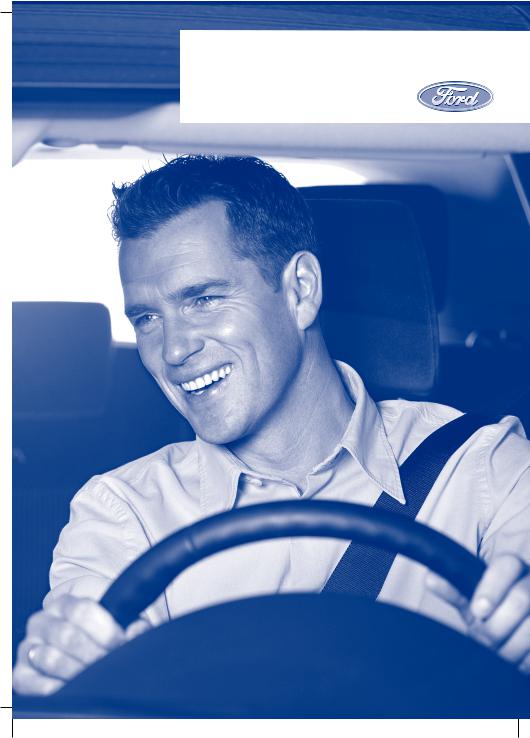
FordTourneoConnect |
|
Feel the difference |
|
|
|||
FordTransitConnect |
|
|
|
Owner'shandbook |
|
|
|
|
|
|
|
|
|
|
|
|
|
|
|

The information contained in this publication was correct at the time of going to print. In the interest of development the right is reserved to change specifications, design or equipment at any time without notice and without incurring any obligations. This publication, or part thereof, may not be reproduced nor translated without our approval. Errors and omissions excepted.
© Ford Motor Company 2007
All rights reserved.
Part number: 7T1J-19A321-DA (CG3526en) 06/2007 20070712082539

Table of contents
Introduction |
|
About this handbook........................ |
5 |
Symbols glossary.............................. |
5 |
Parts and accessories...................... |
5 |
Quick start |
|
Quick start.......................................... |
6 |
Child safety |
|
Child seats........................................ |
12 |
Booster cushions............................. |
13 |
Child seat positioning...................... |
14 |
ISOFIX anchor points....................... |
16 |
Child safety locks............................. |
18 |
Occupant protection |
|
Principle of operation...................... |
19 |
Fastening the seat belts................. |
21 |
Seat belt height adjustment.......... |
22 |
Using seat belts during |
|
pregnancy.................................... |
22 |
Keys and remote |
|
controls |
|
General information on radio |
|
frequencies.................................. |
23 |
Programming the remote |
|
control........................................... |
23 |
Changing the remote control |
|
battery........................................... |
23 |
Locks |
|
Locking and unlocking................... |
25 |
Engine immobiliser |
|
Principle of operation..................... |
30 |
Coded keys..................................... |
30 |
Arming the engine immobiliser...... |
31 |
Disarming the engine |
|
immobiliser.................................... |
31 |
Alarm |
|
Principle of operation..................... |
32 |
Arming the alarm............................. |
32 |
Disarming the alarm........................ |
32 |
Steering wheel |
|
Adjusting the steering wheel......... |
33 |
Audio control................................... |
33 |
Wipers and washers |
|
Windscreen wipers......................... |
35 |
Windscreen washers..................... |
35 |
Rear window wiper and |
|
washers........................................ |
35 |
Checking the wiper blades........... |
36 |
Changing the wiper blades........... |
36 |
Lighting |
|
Lighting control................................ |
37 |
Front fog lamps............................... |
37 |
Rear fog lamps................................ |
37 |
Headlamp levelling.......................... |
38 |
Direction indicators......................... |
40 |
Interior lamps................................... |
40 |
Changing a bulb............................... |
41 |
Bulb specification chart.................. |
45 |
Windows and mirrors |
|
Electric windows............................. |
47 |
Exterior mirrors................................ |
47 |
1

Table of contents
Electric exterior mirrors.................. |
48 |
Interior mirror................................... |
48 |
Rear quarter windows................... |
49 |
Map pockets.................................... |
76 |
Seat back trays................................ |
76 |
Auxiliary input (AUX IN) socket...... |
76 |
Instruments |
|
Gauges............................................. |
50 |
Warning lamps and indicators....... |
51 |
Audible warnings and |
|
indicators...................................... |
53 |
Information displays |
|
Trip computer.................................. |
54 |
Climate control |
|
Principle of operation..................... |
55 |
Air vents............................................ |
55 |
Heated windows and mirrors....... |
55 |
Manual climate control................... |
56 |
Auxiliary heater................................ |
59 |
Seats |
|
Sitting in the correct position........ |
64 |
Front seats....................................... |
64 |
Head restraints................................ |
68 |
Rear seats........................................ |
68 |
Heated seats.................................... |
71 |
Convenience features |
|
Clock................................................. |
72 |
Cigar lighter...................................... |
72 |
Ashtray.............................................. |
73 |
Auxiliary power sockets................. |
73 |
Cup holders...................................... |
73 |
Glove box......................................... |
74 |
Storage compartments................. |
74 |
Starting the engine |
|
General information........................ |
77 |
Ignition switch.................................. |
77 |
Starting a petrol engine.................. |
77 |
Starting a diesel engine.................. |
79 |
Switching off the engine................ |
79 |
Fuel and refuelling |
|
Safety precautions.......................... |
80 |
Fuel quality - Petrol......................... |
80 |
Fuel quality - Diesel......................... |
80 |
Catalytic converter......................... |
80 |
Fuel filler flap..................................... |
81 |
Refuelling........................................... |
81 |
Fuel consumption........................... |
82 |
Technical specifications................. |
82 |
Transmission |
|
Manual transmission....................... |
84 |
Brakes |
|
Principle of operation..................... |
85 |
Hints on driving with ABS............... |
85 |
Parking brake.................................. |
86 |
Traction control |
|
Principle of operation...................... |
87 |
Using traction control..................... |
87 |
Parking aid |
|
Principle of operation..................... |
88 |
2

Table of contents
Using the parking aid...................... |
88 |
Load carrying |
|
General information........................ |
89 |
Roof racks and load carriers......... |
89 |
Cargo nets....................................... |
89 |
Towing |
|
Towing a trailer................................. |
91 |
Driving hints |
|
Running-in........................................ |
92 |
Emergency |
|
equipment |
|
First aid kit......................................... |
93 |
Warning triangle.............................. |
93 |
Status after a |
|
collision |
|
Fuel cut-off switch.......................... |
94 |
Inspecting safety system |
|
components................................. |
94 |
Fuses |
|
Fuse box locations.......................... |
95 |
Changing a fuse.............................. |
96 |
Fuse labels....................................... |
97 |
Fuse specification chart................. |
99 |
Vehicle recovery |
|
Towing points................................. |
100 |
Towing the vehicle on four |
|
wheels.......................................... |
101 |
Maintenance |
|
General information...................... |
102 |
Opening and closing the |
|
bonnet......................................... |
103 |
Engine compartment overview - |
|
1.8L Duratec-DOHC (Zetec)..... |
104 |
Engine compartment overview - |
|
1.8L Duratorq-TDCi (Kent) |
|
Diesel/1.8L Duratorq-TDDi (Kent) |
|
Diesel........................................... |
105 |
Engine oil dipstick - 1.8L |
|
Duratec-DOHC (Zetec)............ |
106 |
Engine oil dipstick - 1.8L |
|
Duratorq-TDCi (Kent) Diesel/1.8L |
|
Duratorq-TDDi (Kent) Diesel..... |
106 |
Engine oil check............................. |
106 |
Engine coolant check................... |
107 |
Brake and clutch fluid check....... |
107 |
Power steering fluid check.......... |
108 |
Washer fluid check........................ |
108 |
Technical specifications................ |
109 |
Vehicle care |
|
Cleaning the exterior...................... |
111 |
Cleaning the interior....................... |
112 |
Repairing minor paint damage..... |
112 |
Vehicle battery |
|
Battery care.................................... |
113 |
Using booster cables.................... |
113 |
Changing the vehicle battery....... |
114 |
Wheels and tyres |
|
General information....................... |
115 |
Changing a road wheel................. |
115 |
Tyre care.......................................... |
121 |
3

Table of contents
Using winter tyres.......................... |
122 |
Type approvals.............................. |
160 |
Using snow chains........................ |
122 |
|
|
Technical specifications................ |
122 |
|
|
Vehicle identification
Vehicle identification plate............ |
125 |
Vehicle identification number |
|
(VIN)............................................. |
125 |
Load apportioning valve (LAV) |
|
plate............................................. |
125 |
Technical specifications
Technical specifications................ |
126 |
Telephone
General information...................... |
133 |
Telephone setup........................... |
133 |
Bluetooth setup............................. |
135 |
Telephone controls....................... |
136 |
Using the telephone - Vehicles |
|
Without: Navigation System..... |
137 |
Using the telephone - Travel Pilot |
|
EX................................................. |
140 |
Voice control
Principle of operation.................... |
143 |
Using voice control....................... |
144 |
Audio unit commands.................. |
144 |
Telephone commands................. |
149 |
Navigation system |
|
commands................................. |
154 |
Climate control commands......... |
154 |
Appendices
Type approvals............................... |
157 |
4

Introduction
ABOUT THIS HANDBOOK
Thank you for choosing Ford. We recommend that you take some time to get to know your vehicle by reading this handbook. The more that you know about it, the greater the safety and pleasure you will get from driving it.
Note: This handbook describes every model and option, sometimes even before they are generally available. It may describe options not fitted to your vehicle.
Note: Always use and operate your vehicle in line with all applicable laws and regulations.
Note: Pass on this handbook when selling your vehicle. It is an integral part of the vehicle.
SYMBOLS GLOSSARY
Symbols in this handbook
WARNING
You risk death or serious injury to yourself and others if you do not follow the instructions highlighted
by the warning symbol.
CAUTION
You risk damaging your vehicle if you do not follow the
instructions highlighted by the caution symbol.
Symbols on your vehicle
When you see these symbols, read and follow the relevant instructions in this handbook before touching or attempting adjustment of any kind.
PARTS AND
ACCESSORIES
Genuine Ford parts and accessories have been designed specifically for your vehicle. Unless we have specifically stated, we have not tested non-Ford parts and accessories and, therefore, we will not guarantee that they are suitable for your vehicle. We recommend that you ask your Ford Dealer for advice on parts and accessories suitable for your vehicle.
5
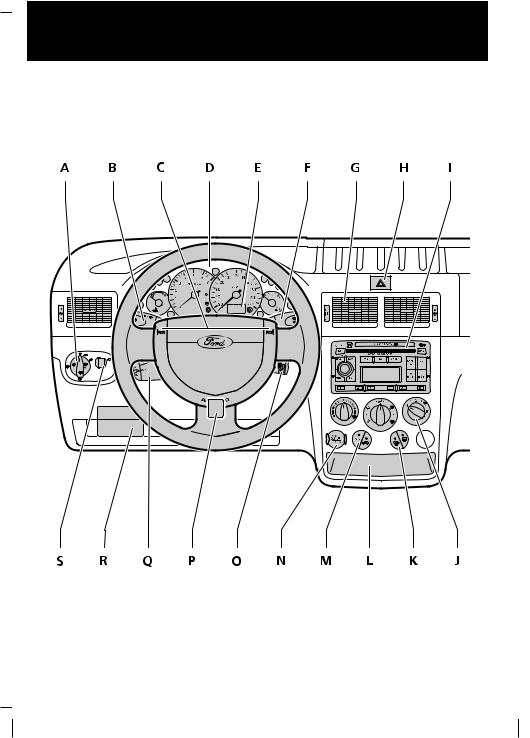
Quick start
QUICK START
Instrument panel overview
Left-hand drive
E74266
6

Quick start
Right-hand drive
I H G B D C E F S
J M K L N Q P O A
E74267
A Lighting controls. See Lighting (page 37).
BDirection indicators. See Lighting (page 37).
CHorn.
D Instrument cluster. See Convenience features (page 72).
EInformation display. See Trip computer (page 54).
7

Quick start
F Wiper lever. See Wipers and washers (page 35).
GAir vents. See Climate control (page 55).
H Hazard warning flasher switch. See Lighting (page 37).
IAudio or navigation unit. See separate handbook.
JClimate controls. See Climate control (page 55).
KHeated windscreen and heated rear window switches. See Climate control (page 55).
LAshtray or storage compartment. See Convenience features (page 72).
MRecirculated air and air conditioning switches. See Climate control (page 55).
NCigar lighter or auxiliary power socket. See Convenience features (page 72).
OIgnition switch.
P Steering wheel adjustment lever. See Steering wheel (page 33).
Q Audio control. See Audio control (page 33).
RFuses. See Fuses (page 95).
SHeadlamp levelling control. See Headlamp levelling (page 38).
8

Quick start
Locking and unlocking the |
Locking and unlocking the |
doors with the key |
doors with the remote |
|
control |
A A
B B
E74800
A Unlock
BLock
Transit Connect
Turn the key to position A to unlock the front doors.
Turn the key to position A twice to unlock all doors.
Tourneo Connect
Turn the key to position A to unlock the front doors.
See Locking and unlocking
(page 25).
A B C
E87379
AUnlock
BLock
CLuggage compartment lid unlock
Transit Connect
Press button A once to unlock the front doors only.
Press button A twice to unlock all doors and the luggage compartment lid.
Press button C once to unlock the luggage compartment lid and the sliding door.
Tourneo Connect
Press button A once to unlock all doors and the luggage compartment lid.
All vehicles
Press button B once to lock all doors and the luggage compartment lid.
Press button B twice within three seconds to activate double locking.
9
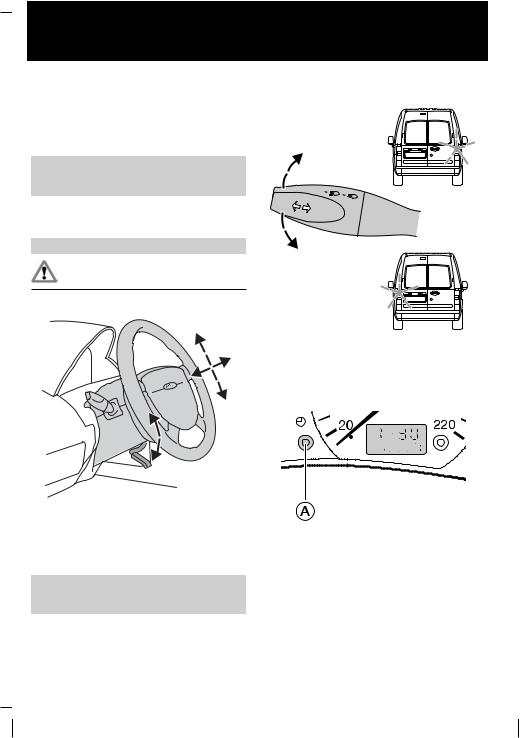
Quick start
Note: The anti-theft alarm system can also be armed independently from the double locking system by turning the door key to the lock position.
See Locking and unlocking
(page 25).
Adjusting the steering wheel
WARNING
Never adjust the steering wheel when the vehicle is moving.
E70358
Release the locking lever to adjust the height of the steering wheel and its distance from the driver.
See Adjusting the steering wheel (page 33).
Direction indicators
E74363
Setting the clock
Version 1
E74265
AToggle and reset button
10
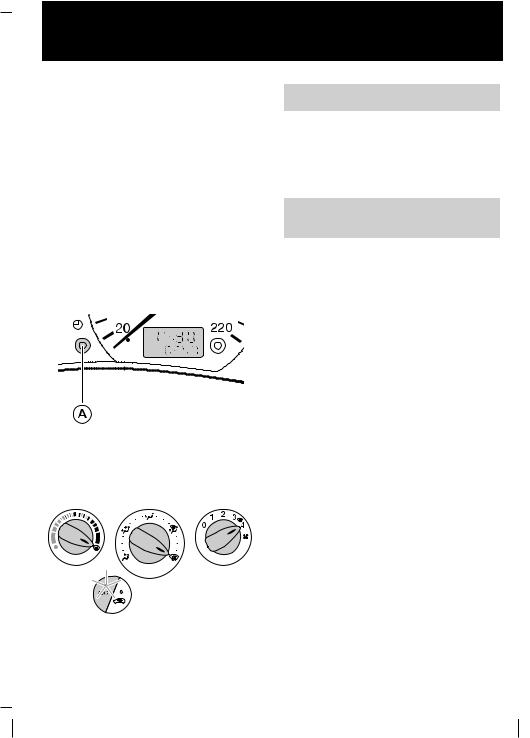
Quick start
•Turn the ignition to position II.
•Hold the button A pressed for at least three seconds until the time in the display flashes.
•To advance the minutes, press the button A. To advance rapidly, hold the button pressed.
To toggle between 12 or 24 hour format, turn the ignition to position I and press the button A.
Version 2
For detailed instructions on how to adjust the clock, refer to the separate audio manual.
See Climate control (page 55).
Engine idle speed after starting
The engine may idle at a higher speed than normal immediately after starting from cold.
See Starting the engine (page 77).
E83530
Press button A to show the time.
Windscreen defrosting or demisting
E74666
11

Child safety
CHILD SEATS
E68916
WARNINGS
Secure children that are less than 150 centimetres tall or less
than 12 years of age in a suitable, approved child restraint, in the rear seat.
Original text according to ECE R94.01: Extreme Hazard! Do not use a rearward facing child restraint
on a seat protected by an air bag in front of it!
Read and follow the manufacturer’s instructions
when you are fitting a child restraint.
Do not modify child restraints in any way.
Do not hold a child on your lap when the vehicle is moving.
Do not leave unattended children in your vehicle.
WARNINGS
If your vehicle has been involved in an accident, have the child
restraints checked by properly trained technicians.
Note: Mandatory use of child restraints varies from country to country.
A choice of ECE approved child restraints which have been specifically tested and approved for your vehicle are available from your Dealer.
Child restraints for different mass groups
Use the correct child restraint as follows:
Baby safety seat
E68918
Secure children that weigh less than 13 kilogrammes in a rearward facing baby safety seat in the rear seat.
12

Child safety
Child safety seat
E68920
Secure children that weigh between 13 and 18 kilogrammes in a child safety seat in the rear seat.
BOOSTER CUSHIONS
WARNINGS
Do not install a booster seat or a booster cushion with only the
lap strap of the seat belt.
Do not install a booster seat or a booster cushion with a seat
belt that is slack or twisted.
Do not put the seat belt under your child’s arm or behind its
back.
Do not use pillows, books or towels to boost your child’s
height.
Make sure that your children sit in an upright position.
WARNINGS
Secure children that weigh more than 15 kilogrammes but are
less than 150 centimetres tall in a booster seat or a booster cushion.
Booster seat
E70710
We recommend that you use a booster seat that combines a cushion with a backrest instead of a booster cushion only. The raised seating position will allow you to position the shoulder strap of the adult seat belt over the centre of your child’s shoulder and the lap strap tightly across its hips.
13
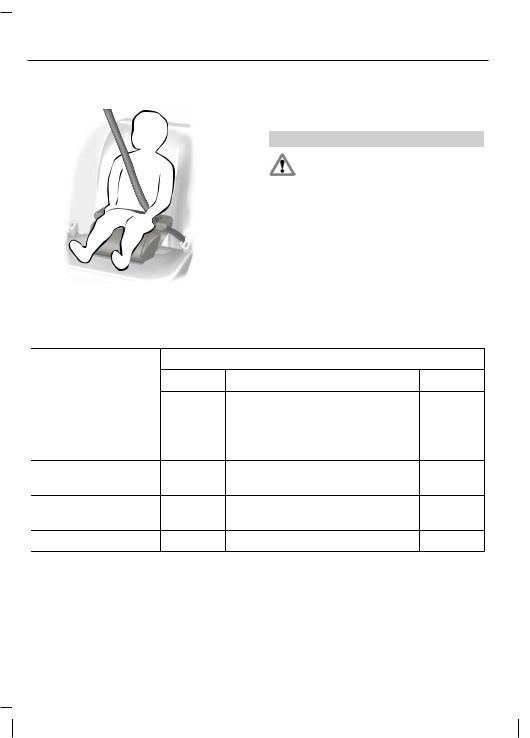
Child safety
Booster cushion |
CHILD SEAT |
|
POSITIONING |
|
WARNING |
|
When using a forward facing |
|
child seat on a rear seat, always |
|
remove the head restraint from that |
|
seat. |
|
|
|
Note: When using a child restraint |
|
on a front seat, it may prove difficult |
|
to tighten the lap section of the seat |
|
belt without slack remaining. If this is |
E68924 |
the case, adjust the seatback to the |
|
fully upright position and raise the |
|
height of the seat. See Front seats |
|
(page 64). |
|
|
Mass group categories |
|
|||
Seating positions |
0 |
0+ |
I |
II |
III |
|
|
|
|
|
|
||
|
Up to 10 |
Up to 13 |
9 to 18 |
15 to 25 |
22 to 36 |
|
|
kg |
kg |
kg |
kg |
kg |
|
Front passenger |
X |
X |
U1 |
U1 |
U1 |
|
seat with airbag |
||||||
|
|
|
|
|
||
Front passenger |
U1 |
U1 |
U1 |
U1 |
U1 |
|
seat without airbag |
||||||
|
|
|
|
|
||
Second row rear |
U |
U |
U |
U |
U |
|
seats |
||||||
|
|
|
|
|
||
Third row rear seats |
U |
U |
U |
U |
U |
|
X Not suitable for children in this mass group.
U Suitable for universal category child restraints approved for use in this mass group.
U1 Suitable for universal category child restraints approved for use in this mass group. However, we recommend that you secure children in a government approved child restraint, in the rear seat.
14

Child safety
ISOFIX child restraints
Seating positions |
|
Mass group categories |
|
||
|
0 |
0+ |
I |
II |
III |
|
Up to 10 |
Up to 13 |
9 - 18 kg |
15 - 25 |
22 - 36 |
|
kg |
kg |
|
kg |
kg |
Second row ISOFIX |
X |
L** |
L** |
X |
X |
seats |
|
|
|
|
|
Second row ISOFIX |
E |
C, D, E |
A, B, B1, |
X |
X |
classes* |
|
|
C, D |
|
|
X Not suitable for children in this mass group.
L Recommended only for the following rearward facing ISOFIX child restraints: Roemer Baby-Safe (E1-04301146), Roemer Baby-Safe Plus (E1-04301146), Britax Cosy Tot (E1-04301146), Britax Cosy Tot Premium (E1-04301146).
L Recommended only for the following forward facing ISOFIX child restraint with top tether (group I): Roemer Duo (E1-40301133).
* As defined by ECE-R16.
N/A Not applicable.
Note: ** When you are purchasing an ISOFIX restraint, make sure that you know the correct mass group and ISOFIX size class for the intended seating locations.
15
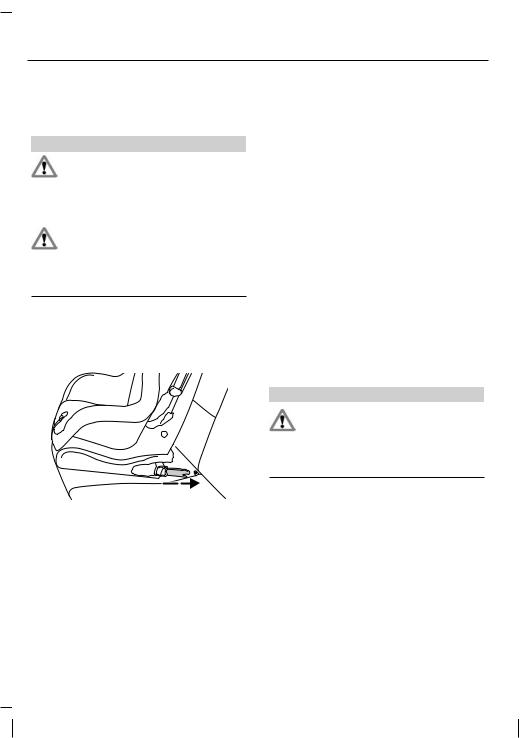
Child safety
ISOFIX ANCHOR POINTS
Tourneo Connect
WARNINGS
Ford does not recommend the use of an ISOfix system without
the use of an anti-rotation device, such as a top tether anchor or support leg, correctly installed.
There is a risk of death or serious injury when the manufacturers instructions are not followed properly or when the child
restraint is modified in any way.
Your vehicle has been equipped with ISOFIX anchor points. Your Ford Dealer will be pleased to make them accessible.
E75769
The ISOFIX system consists of two rigid latching arms on the child seat which attach to anchor points at the bottom of the seat. When made available by your Ford Dealer, the two lower anchor points may be found on the second row centre seat and are labelled with a circular pictogram and the text ‘ISOFIX’. The guides enable the latching arms of an ISOFIX child seat to be easily and securely attached.
ISOFIX child seats not approved by Ford have not been validated by Ford, and neither the suitability nor the safety of such seats can be certified, whether installed using the ISOFIX system or the normal seat belts.
Attaching a child seat with top tethers
WARNING
Attach the tether strap only to the appropriate tether anchor as shown. The tether strap may not
work properly if attached somewhere other than the correct tether location.
A third anchor point has been provided for child seats that are equipped with a top tether, available for use in the forward facing configuration. This additional anchor will enable the use of a top tether strap. Contact your Ford Dealer to have this anchor installed.
16

Child safety
E75770
On vehicles with five seats, the anchor is located at the top of the rear door opening.
E75771
On vehicles with eight seats, it is located on the rear of the second row centre seat.
E75772
The anchor point is identified by a pictogram. The tether strap should be routed beneath the raised head restraint to the anchor point. Remove the anchor point cover and attach the strap. After installing the child safety seat, tighten the tether strap according to the manufacturer’s instructions.
17

Child safety
CHILD SAFETY LOCKS
Tourneo Connect
WARNING
You cannot open the doors from inside if you have put the
child safety locks on.
Note: Child safety locks are only fitted to sliding doors.
A |
B |
E75766
A Lock
BUnlock
18
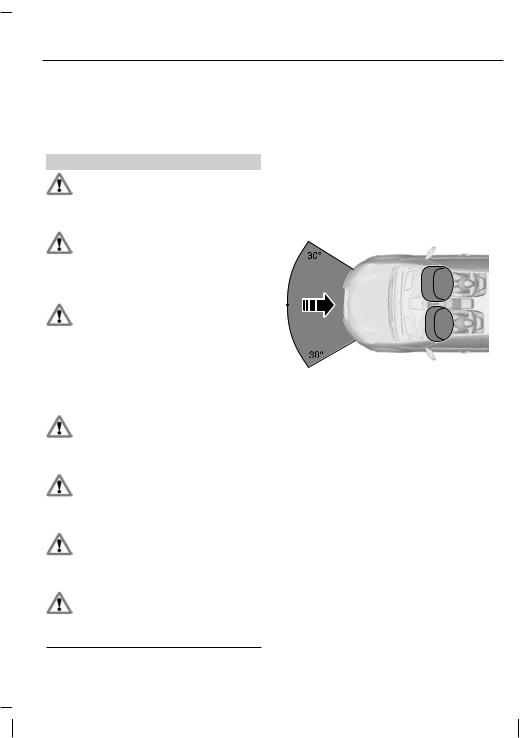
Occupant protection
PRINCIPLE OF
OPERATION
Airbags
WARNINGS
Do not modify the front of your vehicle in any way. This could
adversely affect deployment of the airbags.
Original text according to ECE R94.01: Extreme Hazard! Do not use a rearward facing child restraint
on a seat protected by an airbag in front of it!
Wear a seat belt and keep sufficient distance between yourself and the steering wheel. Only when you use the seat belt properly,
can it hold you in a position that allows the airbag to achieve its optimum effect. See Sitting in the correct position (page 64).
Have repairs to the steering wheel, steering column, seats,
airbags and seat belts carried out by properly trained technicians.
Keep the areas in front of the airbags free from obstruction.
Do not affix anything to or over the airbag covers.
Do not poke sharp objects into areas where airbags are fitted.
This could damage and adversely affect deployment of the airbags.
Use seat covers designed for seats with side airbags. Have
these fitted by properly trained technicians.
Note: You will hear a loud bang and see a cloud of harmless powdery residue if an airbag deploys. This is normal.
Note: Only wipe airbag covers with a damp cloth.
Driver and front passenger airbags
E74302
The driver and front passenger airbags will deploy during significant frontal collisions or collisions that are up to 30 degrees from the left or the right. The airbags will inflate within a few thousandths of a second and deflate on contact with the occupants, thus cushioning forward body movement. During minor frontal collisions, overturns, rear collisions and side collisions, the driver and front passenger airbags will not deploy.
19

Occupant protection
Side airbags
E72658
Side airbags are fitted inside the seatback of the front seats. A label indicates that side airbags are fitted to your vehicle.
The side airbags will deploy during significant lateral collisions. Only the airbag on the side affected by the collision will deploy. The airbags will inflate within a few thousandths of a second and deflate on contact with the occupants, thus providing protection for the chest and shoulder areas. During minor lateral collisions, overturns, front collisions and rear collisions, the side airbags will not deploy.
Seat belts
WARNINGS
Wear a seat belt and keep sufficient distance between yourself and the steering wheel. Only when you use the seat belt properly,
can it hold you in a position to achieve its optimum effect. See
Sitting in the correct position
(page 64).
Never use a seat belt for more than one person.
Use the correct buckle for each seat belt.
Do not use a seat belt that is slack or twisted.
Do not wear thick clothing. The seat belt must fit tightly around
your body to achieve its optimum effect.
Position the shoulder strap of the seat belt over the centre of
your shoulder and position the lap strap tightly across your hips.
The drivers seat belt retractor is fitted with a seat belt pretensioner. Seat belt pretensioners have a slightly lower deployment threshold than the airbags. During significant frontal collisions, it is possible that only the seat belt pretensioners will deploy.
20
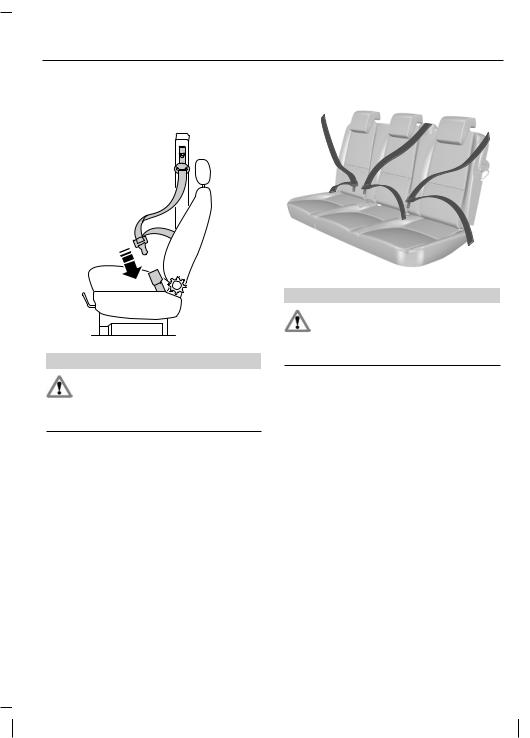
Occupant protection
FASTENING THE SEAT |
Rear seat belts |
BELTS |
|
E66541
WARNING
Insert the tongue into the buckle until a distinct click is heard,
otherwise the seat belt will not be locked correctly.
Pull the belt out steadily. It may lock if pulled sharply or if the vehicle is on a slope.
To release the belt, press the red button on the buckle and let the belt rewind completely and smoothly.
E75564
WARNING
In order to ensure that the centre belt works properly, the
rear seatback must be correctly engaged.
Make sure that each seat belt uses the correct buckle.
21
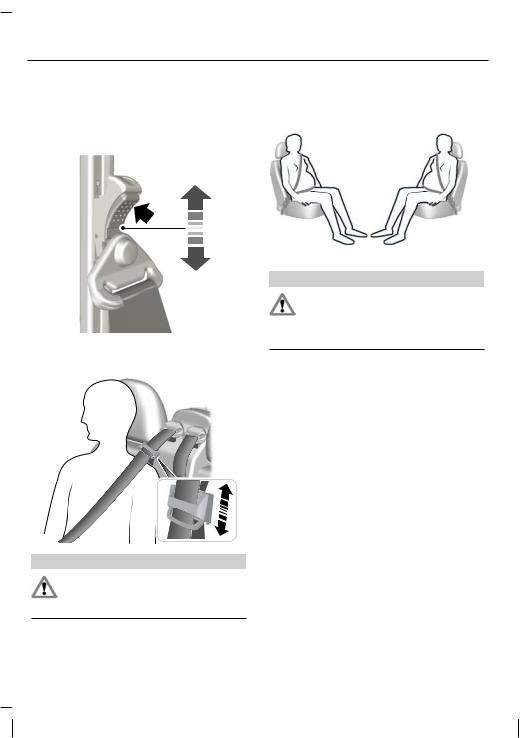
Occupant protection
SEAT BELT HEIGHT |
USING SEAT BELTS |
ADJUSTMENT |
DURING PREGNANCY |
Front seat belt |
|
E68901
Rear seat belt
E73074
WARNING
Make sure that the seat belt runs smoothly through the
guide.
E68587
WARNING
Position the seat belt correctly for your safety and that of your unborn child. Do not use only the lap
strap or the shoulder strap.
Position the lap strap comfortably across your hips and low beneath your pregnant abdomen. Position the shoulder strap between your breasts, above and to the side of your pregnant abdomen.
22

Keys and remote controls
GENERAL INFORMATION ON RADIO FREQUENCIES
CAUTION
The radio frequency used by your remote control can also be
used by other short distance radio transmissions (e.g. amateur radios, medical equipment, wireless headphones, remote controls and alarm systems). If the frequencies are jammed, you will not be able to use your remote control. You can lock and unlock the doors with the key.
Note: You could unlock the doors if you press the buttons on the remote control unintentionally.
The operating range between your remote control and your vehicle varies depending on the environment.
PROGRAMMING THE REMOTE CONTROL
You can programme a maximum of four remote controls to use with your vehicle (including any supplied with your vehicle).
Note: Make sure the anti-theft alarm is deactivated and that all doors are closed.
1.Turn the ignition key from position 0 to position II eight times within 10 seconds. The ignition must end in position II and remain in this position. The door locks will cycle to indicate that it is now possible to programme new remote controls.
2.Press any button on a new remote control within 20 seconds of the door locks cycling. The door locks will cycle again to indicate that the remote control has been successfully programmed.
3.Repeat step 2 for all your remote controls, including your original remote control. Each time a new remote control is successfully programmed, the programming period starts again and it is possible to programme a new remote control for 20 seconds.
4.Turn the ignition to position 0. The door locks will cycle to indicate that the remote control programming is ended. Only the remote controls which you have just programmed are now able to lock and unlock your vehicle.
CHANGING THE REMOTE CONTROL BATTERY
If the range of the transmitter in the key decreases gradually, the battery (type 3V CR 2032) should be replaced.
23

Keys and remote controls
• Carefully prise out the battery with the flat object. Fit the new battery between the contacts with the + sign facing downwards.
Reassemble the transmitter unit in reverse order.
E68726
•Carefully seperate the transmitter unit from the key using a flat object (e.g. a screwdriver) at the recess on the back.
•Carefully prise out the battery with the flat object. Fit the new battery between the contacts with the + sign facing downwards.
Reassemble the transmitter unit in reverse order.
E68727
•Open the transmitter unit by seperating the retaining clips on the sides with the flat object.
E68729
24

Locks
LOCKING AND
UNLOCKING
Central locking
Note: You can unlock the doors and luggage compartment lid with the key. This needs to be used if the remote control system is not functioning.
Note: Unlocking the luggage compartment lid with a key will only unlock that door.
Note: You can only centrally lock the doors if they are all closed.
Note: You can deactivate the central locking system from the driver's or front passenger's door.
Double locking
WARNING
Do not activate double locking when persons or animals are
inside the vehicle. You will not be able to unlock the doors from the inside if you have double locked them.
Double locking is a theft protection feature that prevents someone from opening the doors from the inside. You can only double lock the doors if they are all closed.
E74799
Locking and unlocking confirmation
When you unlock the doors, the direction indicators will flash once.
On vehicles with double locking, the direction indicators will flash twice when you lock the doors.
25

Locks
Locking and unlocking the doors with the key
AA
B B
E74800
A Unlock
BLock
Tourneo Connect (with remote control) and Transit Connect
Turn the key to position A to unlock the front doors.
Turn the key to position A twice to unlock all doors.
Tourneo Connect without remote control
Turn the key to position A to unlock all doors.
Double locking the doors with the key
Turn the key to the unlock position and then the lock position within three seconds to double lock the doors.
Locking and unlocking the doors with the remote control
A B C
E87379
AUnlock
BLock
CLuggage compartment lid and sliding doors unlock
Press button A once to unlock the front doors only.
Press button A twice to unlock all doors and the luggage compartment lid.
Press button C once to unlock the luggage compartment lid and the sliding door.
Press button B once to lock all doors and the luggage compartment lid.
Press button B twice within three seconds to activate double locking.
26

Locks
Note: The anti-theft alarm system can also be armed independently from the double locking system by turning the door key to the lock position.
Locking and unlocking the doors from inside
Front doors
A
B
E74704
A Lock all doors
BUnlock
Note: B will unlock all doors on Tourneo Connect without remote control, or the front doors on Tourneo Connect (with remote control) and Transit Connect
Sliding door
AB
E74706
A Lock
BUnlock
Opening the doors
Sliding door
Note: On Tourneo Connect, the right-hand sliding door is inhibited from opening fully when the fuel filler flap is unlocked and open.
27

|
|
Locks |
|
|
|
Right-hand rear door |
|
|
2 |
|
|
1 |
A |
B |
|
|
|
||
E74705 |
|
|
|
A |
Outside |
A |
B |
|
|
||
B |
Inside |
E74707 |
|
Double rear doors
WARNING
Close the rear doors properly to prevent them from opening
while you are driving. Driving with the rear doors open is extremely dangerous as exhaust fumes can be drawn into the vehicle’s interior.
A Outside
BInside
Left-hand rear door
1
2 |
E74708
28
